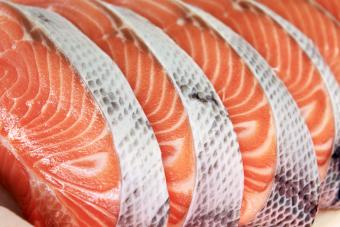
Yes, dogs can eat salmon. Although salmon is generally safe to consume, it's important to understand where the salmon was sourced from.

Salmon is Packed with Beneficial Nutrients
Salmon contains a significant amount of nutrients beneficial to your dog. Not only does it contain essential fatty acids, such as DHA and EPA, but also contains Vitamins A, B, and D, along with zinc, potassium, and magnesium.
The benefits of EPA and DHA include:
- Improved immune system function
- Reduced inflammation
- Skin and coat health
- Proper development for reproducing dogs
- Slowed cancer progression
- Cognitive support
In regard to the other beneficial nutrients, they can offer the following:
- Vitamin A can assist with improving your dog's vision and overall well-being.
- Vitamin B can improve digestive health, aid in cognitive well-being, and improve skin and coat.
- Vitamin D aids in bone growth and health.
- Zinc aids in thyroid function, immune health, and optimal health.
- Potassium aids in successful digestion of essential nutrients.
- Magnesium works at the cellular level, aiding energy production among other roles.

What to Avoid
Avoid canned salmon, as it may contain harmful additives. Pacific salmon and salmon that have been factory-farmed are not recommended. Farmed salmon often contain harmful antibiotics and chemical compounds that were used to help the fish avoid infection and grow to their desired weight. Farmed salmon also contains more PCBs, scientifically known as polychlorinated biphenyls, than wild salmon. PCB levels were found to be eight times higher in farmed salmon.
Generally, salmon is known to be low in mercury. Fish species higher up on the food chain, particularly large predatory fish, are more likely to be high in mercury content. Pacific salmon are known to be high in mercury, whereas Atlantic salmon have significantly lower levels that are safer for your dog to consume.
The skin should also be removed prior to feeding. The skin not only contains an overabundance of fats, but also contains toxins and contaminants. If the skin is fed, this will result in salmon going from beneficial to harmful, which is something dog owners definitely don't want.
How to Feed Salmon
When purchasing salmon, go for a boneless cut. The bones of salmon are fragile. The brittle, fragile bones can choke your dog, get lodged in their throat, or become caught in their intestines. Even if you purchase boneless salmon containing what should only be flesh, it's important to check for any leftover bones that may have made their way to the cut.
If you want to feed salmon raw, it must also be frozen for a week or two before serving. This will kill any parasites or germs that may be present.
If you'd rather cook the salmon, steam it instead of frying to avoid additional fatty oils from being consumed. More omega 3s will also be preserved if the salmon is steamed rather than baked or fried.
Amount to Feed
Salmon can be used in a raw diet rotation or added to your dog's kibble safely in moderate amounts. Salmon should never be fed in amounts higher than 10 grams per pound of body weight. The best way to determine how much salmon should be included in your unique dog's diet is to contact a certified canine nutritionist. This is particularly important if you are implementing a raw diet for your dog. Too much or too little of any ingredient can cause harmful effects.
Feed Salmon Appropriately
The bottom line is, your dog can eat salmon safely as long as there are no added ingredients and it is sourced appropriately. Portion control is also critical to ensure optimal health is achieved. It can provide numerous health benefits if fed appropriately. If you are unsure of how much to include, or where to source, contacting a canine nutritionist is recommended.







